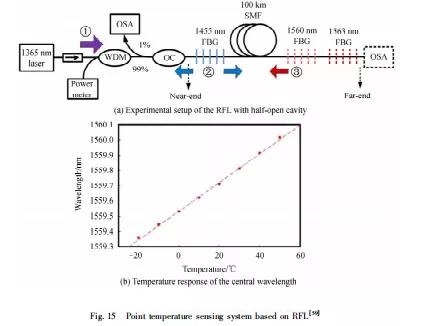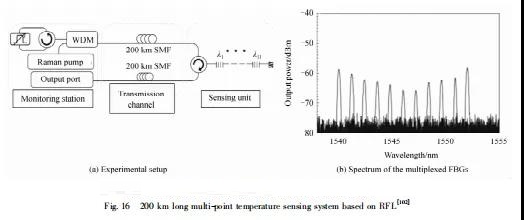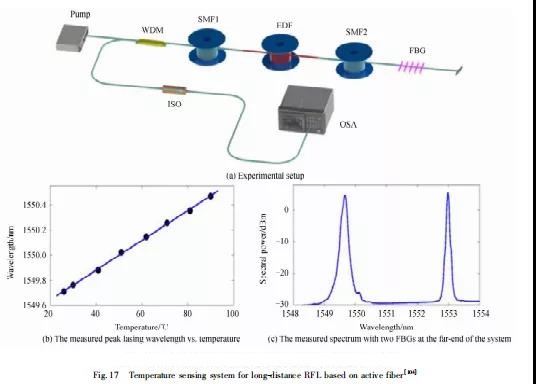

Randomly distributed feedback fiber laser based on Raman gain, its output spectrum has been confirmed to be wide and stable under different environmental conditions, and the lasing spectrum position and bandwidth of the half-open cavity DFB-RFL is the same as the added point feedback device The spectra are highly correlated. If the spectral characteristics of the point mirror (such as FBG) change with the external environment, the lasing spectrum of the fiber random laser will also change. Based on this principle, fiber random lasers can be used to realize ultra-long-distance point-sensing functions.
In the research work reported in 2012, through a DFB-RFL light source and FBG reflection, random laser light can be generated in a 100 km long optical fiber. Through different structural designs, the first-order and second-order laser output can be realized respectively, as shown in Figure 15(a). For the first-order structure, the pump source is a 1 365 nm laser, and an FBG sensor matching the wavelength of the first-order Stokes light (1 455 nm) is placed on the other end of the fiber. The second-order structure includes a 1 455 nm spot FBG mirror, which is placed on the pump end to make it easier to generate lasing, and the 1 560 nm FBG sensor is placed at the far end of the fiber. The generated lasing light is output at the pump end, and temperature sensing can be realized by measuring the wavelength change of the emitted light. The typical relationship between the lasing wavelength and the temperature of the FBG is shown in Figure 15(b).

The reason why this scheme is very attractive in practical applications is: First of all, the sensing element is a pure passive device, and it can be far away from the demodulator (more than 100 km), which is used in many ultra-long-distance application environments. (Such as safety monitoring of power lines, oil and gas pipelines, high-speed rail tracks, etc.) is a must; In addition, the information to be measured is reflected in the wavelength domain, which is only determined by the center wavelength of the FBG sensor, making the system in the pump source power or optical fiber Sensing can be stabilized when the loss changes; finally, the signal-to-noise ratios of the first-order and second-order lasing spectra are as high as 20 dB and 35 dB, respectively, indicating that the limit distance that the system can sense far exceeds 100 km. Therefore, good thermal stability and ultra-long-distance sensing make DFB-RFL a high-performance optical fiber sensing system.
A 200 km point sensing system similar to the above method has also been implemented, as shown in Figure 16. The research results show that due to the long sensing distance of the system, the signal-to-noise ratio of the reflected sensor signal is 17 dB in the best case, 10 dB in the worse case, and the temperature sensitivity is 11.3 pm/℃. The system can realize multi-wavelength measurement, which provides the possibility to measure the temperature information of 11 points at the same time. And this number can be increased. As mentioned in the literature, a fiber random laser based on 22 FBGs can work at 22 different wavelengths. However, the solution requires a pair of optical fibers of equal length, and the demand for optical fiber resources is doubled compared with the aforementioned method.

In 2016, Remote Optical Pumping Amplifier, ROPA in optical fiber communication, using the mixed gain of active gain in active fiber and Raman gain in single-mode fiber, comprehensive theoretical analysis and experimental verification. A long-distance RFL based on active fiber in the 1.5 μm band is presented, as shown in Figure 17(a). In addition, the random laser system also performs well in long-distance point sensing. Take the point-type temperature sensor as an example. The peak wavelength of the random laser output end of this structure has a linear relationship with the temperature added to the FBG, and the sensor system has a wavelength division multiplexing function, as shown in Figure 17(b) and ( c) as shown. In particular, compared to the previous structure, this scheme has a lower threshold and a higher signal-to-noise ratio.

In the future research, through the design of different pumping methods and mirrors, it is expected to realize an ultra-long-distance fiber random laser point-sensing system with superior performance.
Copyright @ 2020 Shenzhen Box Optronics Technology Co., Ltd. - China Fiber Optic Modules, Fiber Coupled Lasers Manufacturers, Laser Components Suppliers All Rights Reserved.